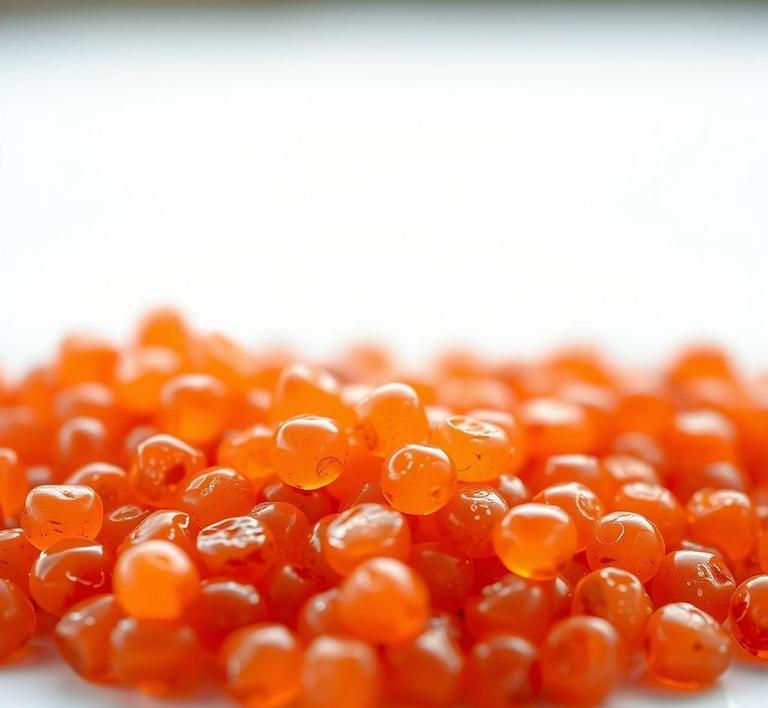Refreezing ikura (salmon roe) can be a bit of a tricky process, but it’s totally doable with the right techniques! If you’ve found yourself with leftover ikura or bought too much, you might be wondering if it’s safe to refreeze it without ruining the delicate texture or flavor. The good news is, with a bit of care, you can preserve those little pearls for future enjoyment. In this guide, we’ll walk you through the best methods to refreeze ikura, how to maintain its quality, and some tips on how to avoid common mistakes that could cause your ikura to lose its signature burst of flavor.
Can You Refreeze Ikura?

Ikura, the vibrant orange salmon roe prized in Japanese cuisine, is a luxurious ingredient that demands careful handling. The question of whether you can refreeze ikura is a common one, especially since ikura is often bought in bulk or as leftovers that didn’t get consumed in one go.
Technically, you can refreeze ikura, but it’s a practice that comes with important caveats. Like many seafood products, ikura is highly perishable, and freezing helps preserve its freshness by halting bacterial growth and enzymatic activity. However, once thawed, the delicate membranes surrounding each roe become fragile and prone to rupture. Refreezing ikura after thawing risks damaging these membranes further, leading to a compromised texture, flavor, and overall quality.
Moreover, food safety guidelines generally advise against refreezing perishable items that have fully thawed because each thawing cycle can increase the risk of bacterial proliferation. If the ikura has been kept cold and only partially thawed, the risks are lower, but full thaw and refreeze cycles are discouraged.
In summary: yes, you can refreeze ikura if absolutely necessary, but it’s best to avoid it to maintain the integrity and safety of the roe.
How To Refreeze Ikura?
If you find yourself needing to refreeze ikura, doing so carefully can mitigate some negative impacts. Here’s an optimal method to refreeze ikura while preserving as much quality as possible:
- Minimize Time at Room Temperature: After thawing, keep the ikura refrigerated at all times. Avoid leaving it out at room temperature because warm conditions accelerate spoilage.
- Check for Freshness: Before refreezing, inspect the roe for any off smells, discoloration, or excessive liquid. If it smells fishy or sour, discard it-refreezing won’t help.
- Use Airtight Packaging: Transfer the ikura to an airtight container or vacuum-seal bag. Removing air is crucial to prevent freezer burn and oxidation, which can further degrade flavor and texture.
- Flash Freeze if Possible: Lay the roe out in a single layer on a parchment-lined tray and freeze quickly. Once solid, transfer to your airtight packaging for longer-term storage.
- Label Clearly: Mark the date on the packaging to keep track of how long it has been frozen. Ideally, refrozen ikura should be used within 1-2 weeks to maintain reasonable quality.
- Thaw Gently When Ready to Use: The next thaw should be slow and done in the refrigerator overnight to avoid sudden temperature changes that can rupture the delicate eggs.
By following these steps, you can reduce the risks of texture degradation and microbial contamination associated with refreezing ikura.
Quality Impact
Refreezing ikura inevitably affects its quality, and understanding these changes helps set realistic expectations.
- Texture: Ikura’s appeal lies partly in its distinctive ‘pop’ – the firm yet delicate membranes burst gently in your mouth, releasing a briny, rich liquid. Thawing and refreezing rupture many of these membranes, resulting in softer, mushier roe that lacks that satisfying pop.
- Flavor: The delicate, oceanic flavor of ikura can diminish with each freeze-thaw cycle. Oxidation and protein breakdown contribute to a muted taste and sometimes off-putting fishiness if mishandled.
- Appearance: Refrozen ikura may leak more liquid (known as ‘brine’), giving it a soggier look and a cloudy, less vibrant orange hue.
- Safety: Each thawing cycle increases the risk of bacterial growth, especially if the ikura is left too warm or refrozen after full thaw. Even with careful handling, some microbial risk is present.
Therefore, while refreezing ikura can be done, it almost always comes at the expense of that premium quality which makes ikura so prized. For the best culinary experience, consuming fresh or once-frozen ikura is ideal.
Ikura is a delicate gem of the sea that deserves careful handling to preserve its signature texture and flavor. While you can refreeze ikura if you must, it’s generally best avoided due to the negative impact on quality and potential food safety concerns. If refreezing is necessary, follow best practices: keep it cold, use airtight packaging, flash freeze if possible, and consume within a short period.
Ultimately, the joy of ikura lies in its fresh, vibrant taste and satisfying mouthfeel – qualities that degrade with repeated freezing. To truly savor this luxury ingredient, plan your portions carefully and enjoy ikura at its freshest for a sublime gastronomic experience.
Is It Safe To Refreeze Ikura?
Ikura, those vibrant, translucent orange salmon eggs, are a delicacy prized for their rich, briny burst of flavor and luxurious texture. When it comes to storing ikura, freezing is a common preservation method because it locks in freshness and flavor effectively. But what about refreezing ikura once it has thawed? Is it safe?
Technically, refreezing ikura can be done, but with several important caveats. The safety and quality of refrozen ikura depend largely on how it was thawed and handled after the first freeze. If ikura is thawed slowly and kept at safe temperatures (ideally below 40°F or 4°C), and has not been left out at room temperature for extended periods, refreezing might be safe from a bacterial contamination standpoint.
However, salmon roe is highly delicate-its texture and flavor are sensitive to freezing and thawing cycles. Every time you thaw and refreeze ikura, the delicate membranes of the eggs can rupture, leading to a loss of that signature pop and a more watery, mushy consistency. This textural degradation can diminish the luxurious eating experience that ikura is known for.
From a food safety perspective, refreezing ikura that was thawed properly and promptly refrigerated usually poses minimal risk. Still, if thawed ikura has been left out for hours or shows any signs of spoilage, refreezing is unsafe.
In short: yes, you can refreeze ikura under the right conditions, but expect some quality loss. If you want to preserve the integrity of the roe, it’s best to freeze once, thaw once, and consume promptly.
Signs That Ikura Should Not Be Refrozen
Knowing when not to refreeze ikura is crucial for both food safety and quality. Here are clear signs that indicate ikura should never be put back in the freezer:
- Off or Sour Odor: Fresh ikura smells briny and ocean-like. If it emits a strong fishy, sour, or ammonia-like odor, it’s a clear red flag that spoilage has begun, and refreezing would be dangerous.
- Slimy or Sticky Texture: Fresh ikura should feel slightly firm and slippery, not sticky or slimy. A slimy coating signals bacterial growth, making it unsafe to refreeze or eat.
- Discoloration: Fresh ikura is bright orange or reddish-orange. Dullness, browning, or grayish hues indicate oxidation or spoilage.
- Mushy or Broken Eggs: Excessively soft, mushy eggs, or a large number of broken/ruptured eggs mean the ikura has deteriorated. Refreezing will only worsen the texture.
- Left Out at Room Temperature Too Long: If ikura has been left out at room temperature (above 40°F / 4°C) for more than two hours (or one hour in hot climates), harmful bacteria could multiply to dangerous levels.
- Visible Mold: Any fuzzy or unusual growth on the surface is a definite no-go.
If you notice any of these signs, the safest choice is to discard the ikura rather than refreeze it. Consuming spoiled ikura can cause foodborne illness.
Common Refreezing Mistakes
Refreezing ikura isn’t just about putting leftovers back in the freezer. Many common mistakes can compromise both safety and flavor:
- Refreezing Without Proper Cooling: Placing ikura back into the freezer immediately after thawing at room temperature encourages bacteria to multiply. Always refrigerate ikura promptly after thawing and keep it chilled.
- Multiple Freeze-Thaw Cycles: Constantly thawing and refreezing ikura breaks down the delicate membranes of the eggs, causing a mushy texture and loss of flavor. Avoid repeated cycles at all costs.
- Not Using Airtight Packaging: Exposure to air during refreezing leads to freezer burn, which dries out the ikura and damages flavor and texture. Always store ikura in airtight containers or vacuum-sealed bags.
- Freezing Large Portions: Freezing ikura in big clumps or containers means that thawing is slow and uneven, increasing the risk of partial thawing and bacterial growth. Instead, portion it out before freezing.
- Ignoring Shelf Life: Even frozen ikura has a shelf life. Refreezing old ikura will not improve its safety or flavor; it only compounds deterioration.
Avoiding these mistakes ensures that refreezing does not become a health hazard or lead to disappointment when enjoying your prized salmon roe.
Tips And Tricks
To get the most out of freezing and refreezing ikura, here are some practical tips and tricks:
- Portion Before Freezing: Divide ikura into small portions before freezing. This way, you only thaw what you need, minimizing leftovers and avoiding refreezing.
- Use Vacuum Sealing: Vacuum sealing ikura before freezing significantly reduces air exposure, preventing freezer burn and maintaining texture.
- Freeze Quickly: Freeze ikura quickly by spreading it out in a single layer on a tray before transferring it to a sealed bag or container. Quick freezing helps preserve the delicate structure of the eggs.
- Thaw Gently: Always thaw ikura slowly in the refrigerator overnight rather than at room temperature or in warm water. This gentle thawing reduces moisture loss and bacterial growth.
- Consume Promptly After Thawing: Once thawed, try to consume ikura within 24 to 48 hours for best freshness.
- Avoid Refreezing Whenever Possible: Plan ahead to avoid the need to refreeze. If you do have to refreeze, ensure the ikura has been kept cold and shows no spoilage signs.
- Enhance Flavor Post-Thaw: If texture suffers from refreezing, consider incorporating ikura into dishes where texture is less critical-like mixed into rice bowls, salads, or sauces-so the flavor shines even if the eggs are a bit softer.
Conclusion
Refreezing ikura is a nuanced issue balancing food safety and quality preservation. While it is technically safe to refreeze ikura if handled properly, every freeze-thaw cycle risks degrading the delicate eggs’ texture and taste. Signs such as off odors, sliminess, discoloration, or improper thawing conditions clearly indicate ikura should never be refrozen.
To enjoy ikura at its best, freeze it once carefully, thaw gently, and consume promptly. Use airtight, portioned packaging and keep it chilled at all times. Avoid common pitfalls like room-temperature thawing and repeated freeze-thaw cycles.
By following these guidelines, you can extend the shelf life of your precious ikura without sacrificing the sumptuous burst of flavor and luxurious texture that make it such a prized treat. Ultimately, thoughtful handling and respect for ikura’s delicate nature are the keys to savoring this exquisite ingredient safely and deliciously.


